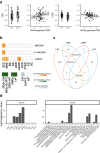Dopamine signaling enriched striatal gene set predicts striatal dopamine synthesis and physiological activity in vivo
- PMID: 38688917
- PMCID: PMC11061310
- DOI: 10.1038/s41467-024-47456-5
Dopamine signaling enriched striatal gene set predicts striatal dopamine synthesis and physiological activity in vivo
Abstract
The polygenic architecture of schizophrenia implicates several molecular pathways involved in synaptic function. However, it is unclear how polygenic risk funnels through these pathways to translate into syndromic illness. Using tensor decomposition, we analyze gene co-expression in the caudate nucleus, hippocampus, and dorsolateral prefrontal cortex of post-mortem brain samples from 358 individuals. We identify a set of genes predominantly expressed in the caudate nucleus and associated with both clinical state and genetic risk for schizophrenia that shows dopaminergic selectivity. A higher polygenic risk score for schizophrenia parsed by this set of genes predicts greater dopamine synthesis in the striatum and greater striatal activation during reward anticipation. These results translate dopamine-linked genetic risk variation into in vivo neurochemical and hemodynamic phenotypes in the striatum that have long been implicated in the pathophysiology of schizophrenia.
© 2024. The Author(s).
Conflict of interest statement
E.D. and G.P. received lecture fees from Lundbeck. A.R. received travel fees from Lundbeck. A.B. received consulting fees from Biogen and lecture fees from Otsuka, Janssen, and Lundbeck. O.D.H. has received investigator-initiated research funding from and/or participated in advisory/speaker meetings organized by Angelini, Autifony, Biogen, Boehringer Ingelheim, Eli Lilly, Heptares, Global Medical Education, Invicro, Janssen, Lundbeck, Neurocrine, Otsuka, Sunovion, Recordati, Roche and Viatris/Mylan and was a part-time employee of H Lundbeck A/s. O.D.H. and M.V. have a patent for the use of dopaminergic imaging. D.R.W. serves on the Scientific Advisory Boards of Sage Therapeutics and Pasithea Therapeutics. The remaining authors declare no competing interests.
Figures




References
Publication types
MeSH terms
Substances
Grants and funding
LinkOut - more resources
Full Text Sources
Medical

